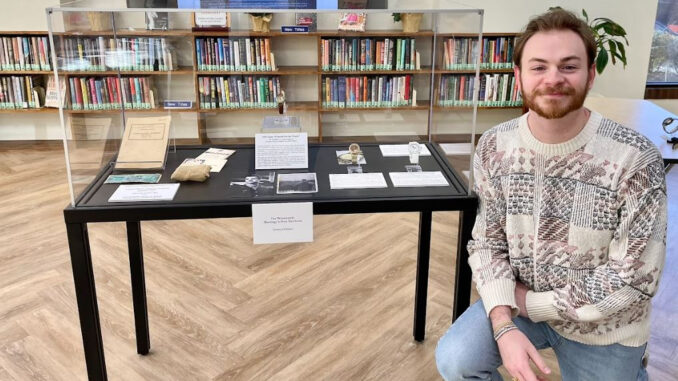
Megan Trotter | News Editor
Repurposed quilts, dog portraits in gold frames and trendy watches took over a small section of Gumberg library’s fourth floor with professor Laura Engel’s graduate exhibit “Curating the Archives,” on Dec. 7.
The exhibit was part of a new cross-listed class between the English graduate program and the public history program with the goal of exploring the idea of archival theory, research and curation.
“The course started out with reading about theories of the archive and also museum exhibitions. We sort of talked a lot about the ways in which people collect things, ‘How did things get preserved?’” Engel said.
The exhibit cumulated a mix of digital and physical displays. On opening night, attendees traveled between the digital projects in Canevin Hall flex-tech classrooms and physical projects in Gumberg library. Only three students in the class chose to complete the project with a tangible abstract.
Griffin Nordstorm, a graduate public history student, put his bachelor’s degree in sculpture and art history from West Virginia University to use in curating his exhibit which explored the history of West Virginia textiles.
“He makes quilts and garments with found materials. He’s perfected, in a kind of a way, to make plastic bags into fabric. It’s unbelievable. And his work is just gorgeous,” Engel said.
Nordstorm’s family has a history of women working as Appalachian quilt makers.
“I was sort of playing with the stuff that was around me in my apartment. I had my own work where I was making reuse, but also, [two quilt pieces] sort of recently moved in with me,” Nordstorm said.
One of the quilts he repurposed was made by his great grandmother that was no longer usable. Nordstorm worked to make it his own by cutting it up and adding pieces of another quilt which he described as “sort of an aesthetic whoopies” due to its strange appearance.
“The show was kind of an exploration of his own artistic practice that derived from his family history,” Engel said.
Originally planned to be displayed for a month, the graduate display was only featured for a week due to conflicts in the library space. However, Nordstorm said that because he still has all the materials from the exhibit, he plans to coordinate a way to showcase his collection again.
Engel said that the students did a lot of research and writing to create exhibits that encompass personal objects that are unique to themselves.
“I feel like it’s really important for students right now to have a kind of visual literacy so the point of the course was to kind of take this larger idea of curating materials and archives [and show that it] can be defined in lots of different ways,” she said.
Maralisa Marra, another student who chose to create a physical exhibit, played around with photographs of her pet beagles. The images were crafted to look like old master portraits such as Vermeer, Van Gough and Rembrandt.
“She had the portraits, which were framed in these really amazing gold frames, next to prints of the original portrait that they were kind of inspired by. Her exhibit was really about the kind of juxtaposition between low and high art and what makes a portrait. What does it mean to use very traditional materials to do something that’s very contemporary,” Engel said.
Similar to both Nordstorm and Marra, Tommy DeMauro, also a public history graduate student, took personal items from home to create his project.
“My topic was talking about how wristwatches embody time itself and are almost heirlooms of time itself. So as time progresses, wristwatches in response to technology both charge the time that passes and also exist as kind of symbols or emblems of how timekeeping has changed over time,” DeMauro said.
DeMauro, from his collection of over 120 watches, carefully selected which to use for the exhibit.
“I have been a watch collector since about the age of 12. And I’ve always had an interest in watches and, as a public history major, watches and jewelry history is one of my favorite areas of history that often gets kind of overlooked,” he said.
The watches fell into three represented categories: familial and personal history; popular history and societal history; and corporate/technological history. Two notable watches included a wristwatch that was previously owned by a U.S. Army soldier who wore the watch overseas during World War II and a reissue of a watch that was once in space.
The most expensive watch featured in his collection was a Seiko Pogue with a yellow dial. It took him several years to track it down due to its rarity, and he paid over $600 to get it.
DeMauro said he enjoyed the idea of working with different departments during the semester-long project.
“I found the class and this project to be extremely interesting and beneficial to not only just English in the history departments, but also Duquesne itself,” DeMauro said. “I think interdisciplinary work is extremely important, not only for academics, academia, its future but also the professional future and landscape as well.”

